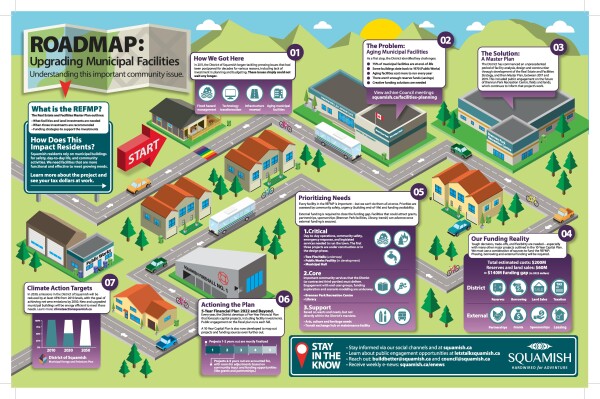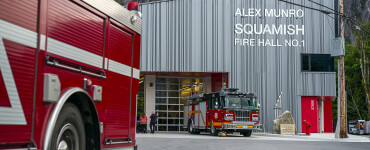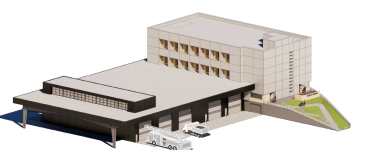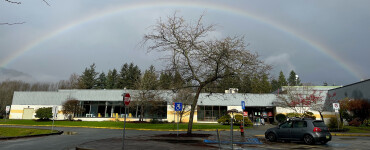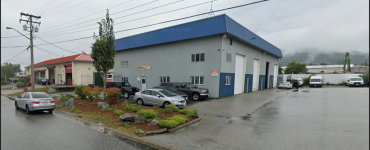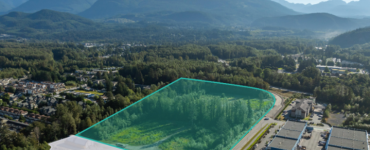Real Estate and Facilities Master Plan
District of Squamish Real Estate and Facilities
Squamish residents rely on municipal facilities for safety, day-to-day life, and community activities. The District manages a portfolio of approximately 1,400 acres of real estate and 18 facilities to provide a range of services. Facilities include: Municipal Offices, Squamish Public Library, Fire Halls, Squamish RCMP, District of Squamish Public Works yards, The 55 Activity Centre, Brennan Park Recreation Centre, and public parks.
Strategy and Master Planning
Since 2011, the District of Squamish has been working through a modernization period to upgrade aging infrastructure and develop long term plans for community resiliency. From 2017-2019, the District underwent an unprecedented period of analysis, planning, and public engagement to understand the needs of the community now and into the future.
In July 2018, Council endorsed the Real Estate and Facilities Strategy (REFS) and the Real Estate and Facilities Master Plan (REFMP) in 2019. The District of Squamish developed a road map for how we will ensure municipal facilities can serve the community over the next 25 years. The REFS identifies facilities that require replacement or upgrade/expansion in order to meet the community’s current and long-term needs. The REFMP determines more precisely:
- “What” facilities and land investments need to be made
- “When” those investments are recommended to be made
- “How” to fund these investments
Strategic plans are now underway with several critical facilities already completed, in progress, or undergoing extensive planning.
Completed Projects
In Progress
Upcoming Decisions
In April 2023, Council endorsed the REFMP Pre-Development Project to undertake due diligence required to support important upcoming decisions on several projects:
- Reviewing the location and scope of the current Municipal Offices and how it will connect to a larger new Civic Hub that could include an expanded Squamish Public Library and community centre, co-location with government and non-government entities such as School District 48, and culture collaboration uses under the GLAM (Gallery, Library, Archive and Museum) umbrella.
- Finalize the scope and select a location for Municipal Offices.
- The final funding approach and whether to own or lease the Municipal Offices, the decision of which has consequences for other projects (eg. Brennan Park and the Innovation Area exploration).
- Potential future phasing for the Civic Hub, as identified above.
- Determining how the additional facilities uses (eg. ice rink, pool and wellness centre) can co-locate together at the Brennan Park location.
- Understanding how these facilities interact or are supported by satellite recreation facilities throughout the community.
- A thorough scan of external funding sources, including grant funding, private operators, partnerships, sponsorship, community amenity contributions and other alternative options.
- The feasibility of creating an Innovation Area on District-owned lands in the Squamish Business Park to maximize the economic development opportunities of these lands including increased economic activity in core, enabling, and emerging economic sectors identified in the Economic Development Sector Strategy.
- The potential to generate proceeds from these lands to support both current 5YFP commitments and future major facility investments at Brennan Park and the Civic Hub.
Resources
Read the background on how the District has arrived at the current Real Estate and Facilities Master Plan.
In April 2018, the District of Squamish completed the Real Estate and Facilities Strategy to ensure it is providing the necessary services to the community in a fiscally responsible manner over the next 25 years.
In 2019, the District completed the Real Estate and Facilities Master Plan to establish a prioritized list of future facility and land investments (“What”), a recommended timeline for making those investments (“When”) and potential funding strategies to support those investments (“How”). Read the Real Estate and Facilities Strategy Executive Summary.
Completed in January 2020, the Squamish Public Library Future Needs Assessment explored the current and future state of the public library.
Completed in 2020, the Arts, Culture & Heritage Strategy provides recommendations on how to nurture a vibrant and resilient arts and culture sector in Squamish.
The Economic Development Strategy road map and action plan provides the District and its stakeholders with tactics, timelines, and ideas for emerging sector development, focused in two thematic areas: the Green Economy and Outdoor Recreation.
The Five Year Financial Plan sets out objectives and policies of the District and includes funding sources, distribution of taxes, and proposed expenditures, among other things.
Frequently Asked Questions
Historically, common practice was to focus on short term tax strategies. Keeping taxes low was the focus at a time when the community was faced with the loss of high-paying industry jobs and a transition to a new economic future was the focus. While these decisions were well-received at the time, hard decisions about long-term planning and infrastructure investment were put off.
2011 saw the beginning of a strategy whereby approval of a long-term financial plan laid the foundation for future Councils to prepare for infrastructure replacement, keeping up with information technology, and eventual replacements of facilities.
Recent Councils and District staff have worked hard to address shortfalls, and simultaneously respond to the rapid growth that has transformed Squamish and created a new set of unique challenges. Affordability, the need for local jobs creation, the need for more employment space for businesses and industry to expand, and the policy work required to help shape a climate change-friendly community of the future are just some of the pressing concerns of recent years.
Looking ahead, the REFMP identifies the need to begin rebuilding financial reserves for the next generation of facility replacements 25+ years from now, once the current facility backlog is addressed (or in 10 years, whichever is earlier).

